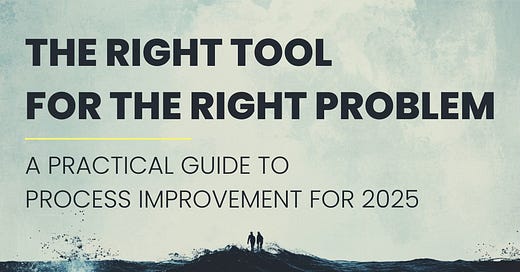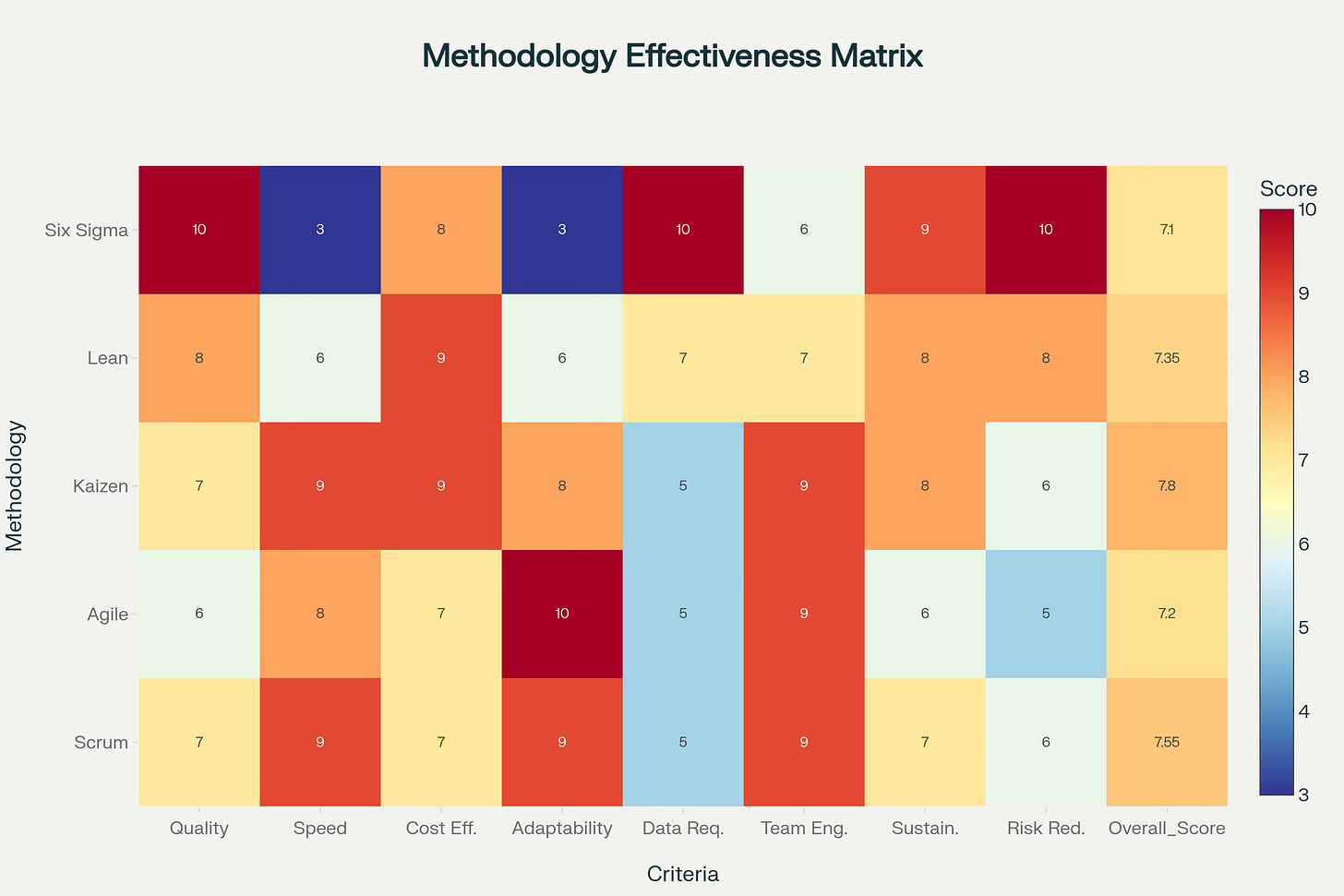Most process improvement initiatives fail. Six Sigma projects fail 50-80% of the time. Lean transformations achieve only "localized improvements" in 35% of cases. Meanwhile, Kaizen achieves 62% sustainability rates.
These operating choices are about real money.
General Electric saved $12 billion over five years with Six Sigma.
Toyota revolutionized manufacturing with Lean.
But for every success story, there are more organizations that burn resources chasing the wrong choice.
This article examines five major frameworks:
Six Sigma, Lean, Kaizen, Agile, and Scrum, comparing them across ROI, speed, failure rates, and industry fit. My goal is straightforward: help you choose the right tool for your specific challenge.
Too Long / Didn’t Read:
Scrum and Kaizen succeed 60%+ of the time; Six Sigma fails 50-80%
Kaizen = fastest results (3 months), Six Sigma = highest ROI (250%)
Manufacturing/Finance → Six Sigma; Tech → Agile/Scrum; Quick wins → Kaizen
Most failures come from picking the wrong tool, not bad execution
Beware consultants pushing one-size-fits-all solutions
Understanding Each Framework
Six Sigma: The Precision Instrument
Born at Motorola in the 1980s, Six Sigma targets 3.4 defects per million opportunities through the DMAIC framework (Define, Measure, Analyze, Improve, Control). It's statistics-heavy and data-driven.
Reality: Six Sigma can deliver up to 350% ROI in manufacturing. But it takes 12 months on average to implement and has the highest failure rate without deep organizational commitment.
Lean: The Waste Eliminator
From Toyota's production system, Lean targets eight types of waste through value stream mapping and just-in-time production. It works across manufacturing, services, and administrative processes.
Reality: 200% average ROI with 8-month implementation. However, 23% of implementations achieve minimal progress, often because organizations treat it as a toolkit rather than a philosophy.
Kaizen: The Culture Builder
Kaizen mobilizes every employee to make small, daily improvements. It's less about tools and more about mindset—continuous improvement through employee engagement.
Reality: Highest sustainability rates (62% reach A or B levels) and fastest implementation (3 months).
Agile: The Shapeshifter
Agile embraces change through iterative development, constant feedback, and cross-functional collaboration. It prioritizes working solutions over comprehensive documentation.
Reality: Agile projects succeed 42% of the time versus 13% for traditional Waterfall. Large organizations struggle when Agile principles clash with existing hierarchical structures.
Scrum: The Sprint Master
Scrum structures Agile into 2-4 week sprints with defined roles (Product Owner, Scrum Master, Team) and ceremonies (standups, retrospectives). It's Agile with more structure.
Reality: 81% of agile teams use Scrum variants, achieving 250% higher work quality when estimation practices are followed. Success depends on disciplined execution.
Performance Data
Success Rates
Scrum: 66%
Kaizen: 62%
Six Sigma: 42%
Agile: 42%
Lean: 40%
The pattern is clear: simpler, more structured approaches succeed more often. Scrum's framework and Kaizen's employee focus outperform the complexity of Six Sigma or comprehensive nature of Lean.
Industry-Specific Performance
The research shows significant performance variations by sector:
Manufacturing
Six Sigma: 350% ROI
Lean: 280% ROI
Statistical control and waste elimination align naturally with production environments.
Healthcare
Six Sigma: 280% ROI
Lean: 220% ROI
Patient safety demands precision. Studies in clinical laboratories documented significant improvements in turnaround times and error reduction through Lean Six Sigma implementations.
Software/Technology
Agile: 250% ROI
Scrum: 230% ROI
Iterative development matches the pace of technical change. Traditional methodologies significantly underperform in this sector.
Financial Services
Six Sigma: 320% ROI
Risk management and compliance require statistical rigor, making Six Sigma particularly effective.
Retail
Lean: 300% ROI
Supply chain optimization and customer flow directly impact margins.
Government
All methodologies underperform. Bureaucratic resistance and political cycles clash with sustained improvement efforts.
Multi-Factor Effectiveness
Scored across eight factors,
quality improvement
speed
cost effectiveness
adaptability
data requirements
team engagement
sustainability
risk reduction
Overall Effectiveness Scores (out of 10)
Kaizen: 7.80
Strongest in speed (9), cost effectiveness (9), team engagement (9)
Weakest in data requirements (5)
Scrum: 7.55
Strongest in speed (9), adaptability (9), team engagement (9)
Weakest in risk reduction (6)
Lean: 7.35
Consistent across all dimensions
No major weaknesses or standout strengths
Agile: 7.20
Strongest in adaptability (10), team engagement (9)
Weakest in sustainability (6)
Six Sigma: 7.10
Strongest in quality (10), data usage (10), risk reduction (10)
Weakest in speed (3) and adaptability (3)
Hybrid Approaches
Organizations are increasingly combining methodologies. Research on U.S. tech startups shows that Agile + Lean Six Sigma combinations achieve:
Higher ROI than single methodologies
Lower defect rates
Better cultural adoption
Common combinations:
Lean + Six Sigma: For healthcare and enterprises needing both efficiency and precision
Agile + Lean: For tech companies balancing speed with quality
Kaizen + Any Framework: As a cultural foundation for sustained improvement
The risk: "framework clash" when methodologies conflict rather than complement. Fast Agile sprints can bottleneck on Six Sigma's data requirements. Kaizen's daily improvements can get lost in Lean's larger transformation projects.
Combinations That Rarely Work
Some methodology pairings create more problems than they solve:
Six Sigma + Agile: The statistical rigor of Six Sigma directly opposes Agile's "move fast and iterate" philosophy. Six Sigma demands months of data collection; Agile demands working software every two weeks. Teams end up paralyzed between competing demands.
Lean + Scrum: Lean optimizes for continuous flow while Scrum creates fixed time boxes. You'll see work pile up at sprint boundaries, defeating Lean's purpose. The tension between "pull when ready" and "push at sprint end" frustrates both approaches.
Traditional Project Management + Kaizen: Gantt charts and milestone planning suffocate Kaizen's daily improvement culture. Employees stop suggesting changes because everything needs approval and scheduling. The methodologies work at fundamentally different speeds.
Multiple Frameworks Simultaneously: Starting Lean, Six Sigma, and Agile transformations at once guarantees failure. Employees get framework fatigue. Middle managers can't champion three different philosophies. Training budgets explode. Pick one, master it, then consider additions.
Why Methods Fail
Six Sigma Failures
Inadequate leadership commitment
Poor project selection
Insufficient statistical training
Result: 50-80% failure rate despite proven ROI potential
Lean Failures
35% achieve only "localized improvements"
Employee resistance to change
Management doesn't model new behaviors
Surface-level implementation
Agile/Scrum Failures
Organizations can't break hierarchical thinking
"Agile in name only" implementations
Misalignment between frameworks and structure
Why Kaizen Succeeds More Often
Low barriers to entry
Immediate employee engagement
Quick wins build momentum
Cultural transformation happens organically
Choosing the Right Methodology
Use Six Sigma when:
Quality defects threaten your business
You have 12+ months for transformation
Statistical data is available
Leadership will champion the change
Use Lean when:
Waste clearly impacts margins
You need results in 6-8 months
Process flows can be mapped
Middle management will drive change
Use Kaizen when:
You need wins in 3-6 months
Employee engagement is low
Budget constraints exist
Cultural change is the goal
Use Agile/Scrum when:
Requirements change frequently
Customer feedback drives development
Cross-functional collaboration is possible
Traditional planning fails consistently
Implementation Guidelines
The research indicates that "thoughtful methodology selection, combined with strong leadership commitment and appropriate training, represents the most critical factor in achieving sustainable process improvement results."
Your approach should be:
Diagnose accurately: Identify your specific failures and root causes
Match method to maturity: Don't attempt Six Sigma if you can't sustain basic Kaizen
Start small: Use quick wins to build momentum before adding complexity
Measure consistently: Track both outcomes and adoption rates
Adapt as needed: Modify frameworks to fit your reality
The best methodology is the one your people will actually use.
Toyota didn't succeed because of Lean. Lean succeeded because of Toyota's commitment.
GE didn't win with Six Sigma. They won with leadership driving Six Sigma.
Choose your tool. Commit to it. Execute consistently.
That's how operational excellence becomes organizational capability.
A Note on Consultants and External Help
Process improvement consulting is a $30+ billion industry, and consultants will happily sell you any methodology. Here's the reality:
When consultants make sense:
Six Sigma implementations almost always need external expertise for statistical training and project setup. Budget $50-200k for initial engagement.
Major Lean transformations benefit from experienced eyes who've seen multiple implementations. Expect $100-300k for enterprise-wide rollouts.
First-time Agile adoptions in traditional companies often need cultural change agents. Figure $75-150k for transformation support.
When to go it alone:
Kaizen can and should start internally. If consultants push expensive Kaizen programs, run.
Scrum has excellent free resources. Two-day training plus online materials beat most consulting engagements.
Pilot programs in single departments rarely need external help.
Red flags to watch for:
Consultants who push their methodology regardless of your situation
"Certification mills" that prioritize training revenue over implementation success
Firms that can't show specific ROI from previous clients in your industry
Any consultant who won't commit to knowledge transfer, you should own the process when they leave
The consultant test: Ask them to explain why their recommended approach might fail in your organization. Good consultants know the limitations. Great ones help you plan for them.
Remember: The best consultants make themselves unnecessary. If they're not building your internal capability, they're building their recurring revenue.
Essential Reading
The Toyota Way by Jeffrey Liker
The definitive book on Lean thinking from 14 years studying Toyota. Shows how principles matter more than tools.Out of the Crisis by W. Edwards Deming
The foundation of modern quality management. Written in 1982, still the intellectual bedrock of Six Sigma and continuous improvement.The Lean Startup by Eric Ries
The modern classic that merged Lean with Agile for the digital age. Essential for anyone in tech or innovation-driven industries.The Goal by Eliyahu Goldratt
Written as a novel, teaches Theory of Constraints through story. The most accessible book on process thinking ever written.Scrum: The Art of Doing Twice the Work in Half the Time by Jeff Sutherland
From Scrum's co-creator. Cuts through the jargon to show why Scrum works and how to actually implement it.
Start with The Goal if you're new to process thinking, or jump straight to the book matching your chosen methodology.
What's your experience with process improvement? Which methodology has worked (or failed) for your organization?
I sincerely hope this was helpful.
Thank you for taking the time to read.
If you are helped by (or just enjoy) what I do, choosing to become a paid subscriber would mean a great deal. It helps me to continue produce the work and lets me know it’s useful.
I’m very excited to keep growing the scope and value of I am able to provide with Operating.







